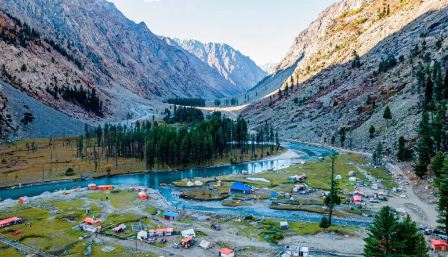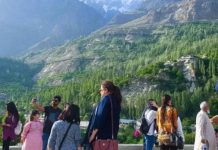PESHAWAR, Sep 26 (APP):As the late summer sun peeks through rain-kissed clouds, the serene valleys of Khyber Pakhtunkhwa (KP) are welcoming a wave of tourists and adventure sports enthusiasts, all drawn by the region’s breathtaking natural beauty.
Nathiagali, perched in the western Himalayas, has turned into a canvas of colours, clouds, and cool breeze, creating a perfect prelude to the winter season.
After a night of rain, the scenic trails of Ayubia, Mukshpuri Top, and Donga Gali bustle with life. Children giggle on swings, couples ride the chairlifts, and amateur photographers scramble to capture the play of mist over the snow-capped peaks of Miranjani.
But beyond the Instagram-perfect moments lies a deeper story of economic opportunity, ecological balance, and a province finding its identity in ecotourism.
For many like Dr. Naveed Farooq, an assistant professor at Abdul Wali Khan University, KP’s mountain retreats are more than just a weekend escape and soul refreshing sanctuaries.
“I return every summer,” he shares while sipping tea in a Nathiagali café. “The serenity of Swat and Nathiagali recharges me. The trout fish, river rafting, snowfalls are a complete experience.”
“Today is the age of digital media and artificial intelligence. Such beautiful tourism destinations if properly highlighted through digital media platforms can bring an economic turnaround to Pakistan,” he says.
Dr. Naveed is among thousands of domestic travelers who have turned to KP’s eco-spots to unplug from the urban grind. And with smartphones in every pocket and drone cameras in the sky, KP’s hidden gems are now accessible to the world digitally.
However, this surge in tourism is not without challenges. Accommodation rates in Nathiagali and surrounding resorts have skyrocketed, often ranging between Rs7,000 to Rs20,000 per night pricing out middle and low-income families.
“Nature belongs to everyone, not just those who can afford five-star lodges,” said Nasir Khan, a property dealer from Nowshera. “If unchecked, this kind of exploitation will discourage tourism rather than promote it.”
This pricing problem has drawn the attention of local authorities, who now face the difficult task of regulating the booming, but uneven, tourism economy.
In a bid to make nature affordable again, the KP Tourism Department has introduced eco-friendly camping pods across major tourist spots. These small wooden structures, often located near lakes, valleys, or dams, offer modest but comfortable stays at Rs3,500–5,000 per night which is far more accessible than private hotel rooms.
Already operational in places like Sharan, Swat, Chitral, and Tandyani, the pods are rapidly gaining popularity.
“Each pod has two to four beds, a washroom, and a kitchen area which is an ideal for families,” said a Tourism Department spokesperson. “These are not just accommodations; they are experiences that bring people closer to nature.”
KP is not relying solely on its famous peaks. The government is actively developing lesser-known destinations ie from the pine-laden valleys of Khanspur and Kumrat to the emerald waters of Mahudand Lake, and from the rugged beauty of Chitral’s Broghil Valley to the colonial-era hiking tracks in Upper Hazara.
Ecotourism spots are also being created near small dams like Tanda (Kohat), Chattri (Haripur), and Naryab (Hangu), allowing day-trippers and families to enjoy scenic getaways without long travel.
A key driver behind KP’s tourism boom is security and accessibility. The launch of Tourist Police in Hazara and Malakand divisions, fluent in multiple languages and trained in crisis response, has increased confidence among travelers.
For added assurance, the government launched a Tourist Safety App, enabling direct contact with emergency services — especially useful for solo travelers and foreign tourists.
Road infrastructure has also received a major boost, with smoother routes now connecting remote locations like Bishigram Lake and Kandal. Jeep tracks and hiking trails, once inaccessible, are being revived some dating back to the colonial era.
KP’s rich blend of ecological and cultural diversity makes it a unique destination. From archaeological ruins in Swat to Sufi shrines in D.I. Khan, and from traditional Kalasha culture in Chitral to the music of tribal communities as every journey here is a living story.
Director General Habib Arif of the KP Culture and Tourism Authority believes that ecotourism can empower youth, especially in rural areas.
“Every pod we build, every trail we revive, creates local jobs — guides, cooks, porters, drivers. That’s how you beat unemployment and protect nature at the same time,” he said.
With rising climate concerns and over tourism threatening Pakistan’s northern belt, KP’s pivot to sustainable, experience-based tourism is timely. If managed wisely, ecotourism can turn the province into an economic powerhouse — while preserving its natural treasures for generations to come.
As the mist settles over the Galiyat hills and camera lenses continue to click, one thing is clear that the world is watching KP, not just for its beauty, but for how it redefines tourism in the age of climate and culture consciousness.

















